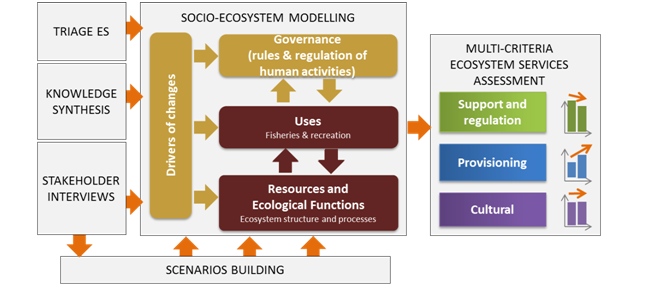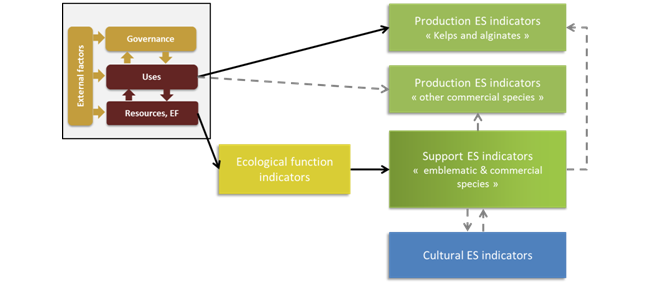3.9.3 System dynamic modelling

This kind of model is able to highlight the trade-offs involved by management options, taking into account the dynamic of ecological and social processes and the interconnectedness of marine ecosystem services.
System dynamic modeling has become one of the most suitable approaches for dealing with environmental sustainability problems, as it makes social-ecological interactions central to a systems approach, thus facilitating interdisciplinary collaboration [Boulanger and Bréchet, 2005].
System dynamic models present known limits and weaknesses.
- First, these models are not well adapted to dealing with multiple levels or scales, except when several models are combined.
- Second, they cannot easily take uncertainty into account, as they are based on fixed relations between variables while consuming a high number of coefficients.
For these reasons, they are highly sensitive to the assumptions formulated during the parameterization step. Nevertheless, a system dynamic model is useful whenever sufficient data are available to feed it, as it allows for communication between stakeholders and scientists, making it a preferable instrument for the integrated assessment of environmental problems and the simulation of exploratory scenarios, as distinct from predictive or normative scenarios [Mongruel et al., 2013].

Example
In the Parc Naturel Marin d'Iroise case study site, a system dynamic model was developed to simulate kelp forest management options, using the most advanced available knowledge through expert participation and stakeholder interviews. This participative socio-ecosystem modelling aimed at representing the kelp forest ecosystem and its services according to a “REFUGE” projection, which includes Resources and Ecological Functions, Uses and Governance.
 Figure: Modelling approach in the Parc Naturel Marin d'Iroise case study site
Figure: Modelling approach in the Parc Naturel Marin d'Iroise case study site
The “Resources and Ecological Functions” component of the model is based on a population dynamic model of kelp:
- the “Uses” component is a bio-economic model of kelp harvesting, and
- the “Governance” component encompasses access rules which can be modified for comparing management options.
The model is able to estimate a series of parameters for a multicriteria assessment. For instance, the “Resources and Ecological Functions” component simulates kelp biomass and kelp plants size: the first parameter is then connected with the kelp exploitation module which estimates economic indicators, and the second one can be used to assess other key ecological functions such as support function for biodiversity, other commercial species or emblematic species.

Figure: Ecosystem services indicators simulated by the kelp forest system dynamic model


